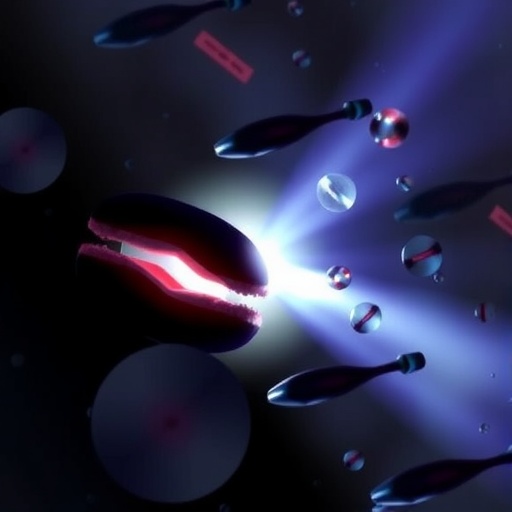In a remarkable stride toward enhancing biotechnological applications, researchers from the renowned laboratory, led by Philipp Mayrhofer and Andreas Skerra, have unveiled an innovative Fc-specific monovalent protein G. This cutting-edge protein, engineered specifically for affinity purification, showcases a unique capacity for light-controlled functionality, consequently streamlining the process of antibody extraction and purification. This development holds significant promise in various fields, including therapeutics and diagnostics, underscoring the essential nature of proteins in modern biotechnology.
Monovalent protein G represents a significant advancement over traditional bivalent versions due to its unique binding characteristics. By focusing exclusively on the Fc region of antibodies, the engineered protein enhances binding affinity and specificity without the complications associated with bivalency. In the past, achieving precise control over affinity purification processes presented numerous challenges, often resulting in suboptimal yields or co-purification of non-target substances. Mayrhofer and Skerra’s innovative approach effectively addresses these challenges, demonstrating clear advantages in both efficiency and specificity.
One of the key features of this engineered protein is its light-activated mechanism. This advancement aligns with the growing trend towards utilizing optogenetics in biological applications. By incorporating light-responsive elements, the researchers designed a protein that can be activated or deactivated with the introduction of specific wavelengths of light. This allows for precise control over the binding process in real time, enabling scientists to perform purifications with unprecedented accuracy while reducing the risk of cross-reactivity or contamination that often accompanies traditional methods.
The engineering of this monovalent protein G involved complex molecular modifications to enhance its properties. Researchers employed cutting-edge techniques such as site-directed mutagenesis and phage display technology to create variants with optimized binding affinities. The resulting protein constructs exhibited exceptional stability and specificity towards various antibody isotypes, which is critical in diverse experimental contexts. This focused engineering approach emphasizes the intrinsic versatility of protein design, demonstrating how targeted modifications can yield significant improvements in functionality.
The ability to switch on and off the binding activity using light opens up new avenues for the real-time monitoring of biological processes. In laboratory settings, this capability allows researchers to adapt purification conditions dynamically, potentially leading to enhanced yields and purity levels. Such advancements could substantially improve the production processes for therapeutic antibodies, which are highly valuable in treating a range of diseases, from autoimmune disorders to cancer.
Moreover, the engineered monovalent protein G could play a pivotal role in the development of antibody-based diagnostics. By allowing for precise and selective antibody isolation under controlled conditions, it could facilitate the creation of highly accurate diagnostic tests. This is particularly relevant in the context of rapidly evolving infectious diseases, where timely and reliable diagnostic solutions are critical.
As these researchers continue to unveil the intricacies of their engineered protein, it becomes evident that the implications of this work extend well beyond the laboratory bench. The commercial potential for such innovations is immense, particularly within the biopharmaceutical industry, which relies heavily on antibody production for therapeutic purposes. Companies may soon leverage these advancements to enhance their manufacturing processes, resulting in more cost-effective and efficient production methods.
Furthermore, the methodology presented in this study serves as a blueprint for future protein engineering endeavors. Researchers can draw upon these principles to create other monovalent proteins tailored for novel applications or enhanced specificity. As the demand for customized proteins increases, such engineering strategies will likely gain prominence across multiple disciplines, including biotechnology, synthetic biology, and drug development.
This breakthrough also aligns with the broader trend of integrating green chemistry principles into laboratory practices. By utilizing light as a control mechanism, the protein purification process may reduce the need for harmful chemical reagents, making it more environmentally friendly. Such considerations are increasingly essential in today’s scientific community, where sustainability is placing a significant emphasis on environmental impact.
In conclusion, the innovation presented by Mayrhofer and Skerra heralds a new era in the field of protein engineering and antibody purification. By developing a light-controlled, monovalent protein G specifically targeting the Fc region of antibodies, they have not only advanced our understanding of affinity purification but have also opened doors to novel applications and methods in biotechnology. The future of antibody purification is bright, with this pioneering research paving the way for more efficient and environmentally considerate approaches to biotechnology.
As additional studies explore the efficacy of this engineered protein in various settings, it may soon become a staple in laboratories worldwide, revolutionizing how researchers interact with and utilize antibodies. The anticipated impact of these advancements underscores the importance of ongoing research in protein design and purification, highlighting the limitless opportunities that lie ahead.
Given the potential for optimized antibody production, enhanced diagnostic accuracy, and the integration of sustainable practices, it is clear that the work of Philipp Mayrhofer and Andreas Skerra represents a significant leap forward in biotechnological applications. This research not only marks an accomplishment in protein engineering but also exemplifies the continuous evolution of methodologies that are set to define the future of scientific progress.
In summary, the engineering of an Fc-specific monovalent protein G is not just an innovation but rather a pivotal milestone in enhancing the methods of antibody purification and production. Its implications stretch across therapeutic and diagnostic domains, promising to reshape the landscapes of these critical fields. As we reflect on this remarkable development, it is impossible not to be excited by the future possibilities it holds for biotechnology.
Subject of Research: Engineering of an Fc-specific monovalent protein G for antibody purification.
Article Title: Engineering of an Fc-specific monovalent protein G for the light-controlled affinity purification of antibodies.
Article References: Mayrhofer, P., Skerra, A. Engineering of an Fc-specific monovalent protein G for the light-controlled affinity purification of antibodies.
Sci Rep 15, 38111 (2025). https://doi.org/10.1038/s41598-025-25894-5
Image Credits: AI Generated
DOI: 10.1038/s41598-025-25894-5
Keywords: Protein Engineering, Antibody Purification, Light-Controlled Mechanisms, Biopharmaceuticals, Monovalent Protein G.
Tags: advancements in diagnostic technologiesaffinity purification advancementsantibody purification techniquesbiotechnological applications of proteinschallenges in protein purificationengineered proteins for therapeuticsFc-specific monovalent proteininnovative light-responsive proteinslight-activated protein Goptogenetics in biotechnologyPhilipp Mayrhofer and Andreas Skerra researchspecificity in antibody extraction





